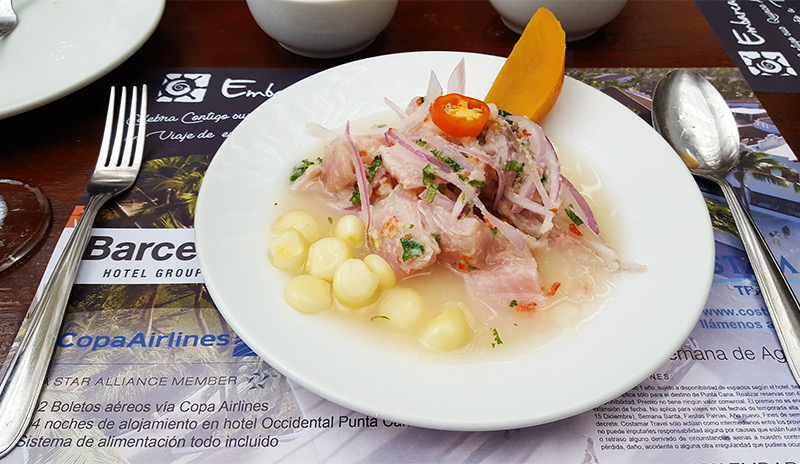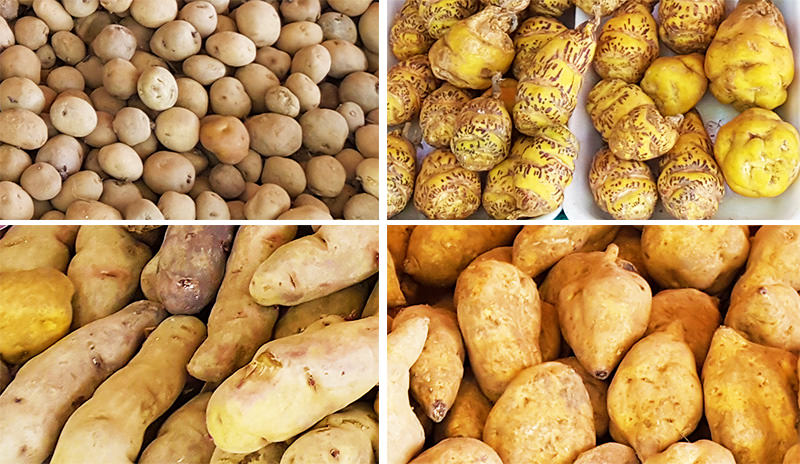Peru, a Foodie's Dream: What You Need to Know About Peruvian Food
When we talk about Peru, we often think of Machu Picchu. However, Peru offers much more than just iconic sights. Its delicious cuisine is world-famous. It's been the winner of the World's Leading Culinary Destination awarded by the World Travel Awards for seven consecutive years, the only country to win the prize since the awards began in 2012. The country's capital, Lima is considered the culinary capital of Latin America. No wonder foodies from the world over flock to this amazing land in search of fabulous culinary experiences. If you are also thinking about a foodie trip to Peru, here are some incredible things about the cuisine.
 Machu Picchu is stunningly beautiful
Machu Picchu is stunningly beautiful
Peru boasts an abundance of ingredients that make distinctive regional cuisines
Peru is the third largest country in South America, after Brazil and Argentina, with a variety of landscapes, ranging from the desert strip on the Pacific coast where its capital Lima is located to the Andes, the world's longest mountain range, and the Amazon basin, with the largest rain forest on earth. Thanks to its diversity in landscape and climate (Peru has 28 diverse microclimates), Peru has a great variety of fresh local produce in different regions, most of which are essential ingredients of the local people. This can be seen in the traditional regional dishes that have been passed down from generation to generation.
The coastal region
Because of the Humboldt Current (also Peru Current) which is responsible for 18 to 20 percent of the marine fish catch in the world, this area is known for its remarkable diversity of seafood, including sardines, anchovies, mackerel, hake, and squid. The national dish of Peru, ceviche (marinated raw fish), finds its origins here. Other popular seafood dishes include chupe de camarones (shrimp cioppino).
 Seafood in Lima
Seafood in Lima
 Ceviche, the national dish of Peru
Ceviche, the national dish of Peru
Up to the Andes
As you explore higher to the valleys and plains of the Andes, you'll find that food there is mainly based on corn and potatoes, two key energy sources of the Inca Empire (1438–1533). Potatoes were first developed here about 8,000 years ago, and Peru has an amazing number of different varieties of potatoes (some estimate over 4,000 varieties), many of which are still used in cooking today. For instance, papas a la huancaína, which is boiled potatoes ladled with spicy, creamy sauce, is a noteworthy dish in the bustling Huancayo that sits in the central highlands.
 All kinds of potatoes in a local market
All kinds of potatoes in a local market
Meats from indigenous animals such as alpacas and cuy (guinea pigs) are the main source of protein for the local people, but there are also sheep, cattle and swine that were introduced by the Spanish. Thus, the quintessential cuisine of the highlands is pachamanca, a traditional dish made from meat, herbs, and vegetables cooked underground with heated stones.
Down to the Amazon rainforest
Food in the Amazon region is prepared with the local produce from freshwater fish to tropical fruits and vegetables. You'll marvel at its colorful array of bizarre food that is not seen anywhere else in the world. The most unmissable specialty is the delicious juanes, steamed rice, and fish wrapped in a jungle leaf, which is easily taken away for a long riverboat ride. Parrilladas de la selva, barbecued rainforest meats marinated in Brazil nut sauce is also a hallmark dish in this region. Belén Mercado, a traditional market in Iquitos which is the largest metropolis in the Peruvian Amazon, is a popular place to sample bizarre food including meaty Amazon worms, simmered sabalo fish intestines and fried leafcutter ants.
Peruvian cuisine is a fusion of local and international flavors
Rooted in the indigenous traditions, Peruvian cuisine has gained influences from other cultures including European, African, and Asian over the past several hundred years. The result is a fusion cuisine that reflects the nation's multicultural history.
Spanish influence
The Spanish conquered the Inca Empire in the 16th century. They brought cows, pigs and goats to this ancient land where people traditionally gained much of their meat and protein from the cuy (guinea pig). They also introduced cabbage, peaches, apples, garlic and onions.
 Vegetables in Lima
Vegetables in Lima
African influence
The Spanish brought African slaves who accounted for the use of grains, yams, peanuts and sugarcane in Peru. African families had to rely on unused meat, entrails, and leftovers that the Spanish wouldn't eat. They used a lot of spices to make them more appetizing. If you want to get a taste of Afro-Peruvian food, tacu tacu is the one you should try. It is leftover beans and rice spiced with hot pepper and garlic, often served with pork, beef or an egg.
Chinese influence
In the 19th century, a wave of Chinese laborers came to Peru. These immigrants brought soy sauce, rice and different cooking techniques, which created a blend of cuisines called chifa (derived from Mandarin "chi-fan", meaning "to eat rice"). The Peruvian ingredients combined with Chinese cooking techniques have generated a unique dining experience that is popular throughout the country. (Lima alone has thousands of chifa restaurants.) A typical example is kamlu wantan, crispy fried wontons served with pork and vegetables. It is a must-eat if you visit Lima.
 Chinese-influenced dish in a chifa restaurant
Chinese-influenced dish in a chifa restaurant
Japanese influence
The Japanese arrived in Peru in the late 19th century and created what is now called Nikkei cuisine. The biggest influence the Japanese have on the Peruvian cuisine is the preparation of seafood, which has been elevated to an art form. For example, ceviche, Peru's most iconic dish, uses cubed morsels of fresh fish such as calamari or scallops marinated in lime, chilies, and onion. Tiradito, a dish of raw fish, is prepared by using sashimi-style seafood bathed in a piquant sauce of lime, ginger and aji amarillo.
World-class restaurants and chefs
With its unique fusion of food, Peruvian cuisine is widely recognized as one of the best in the world. There is a wealth of fine restaurants in the country especially in the capital city Lima, providing some of the world's most amazing dining scenes. Some of these restaurants are among the best in the world. In 2018, three of Peru's eateries were among the World's 50 Best Restaurants: Central, Maido, and Astrid y Gastón.
Maido, which specializes in Peruvian-Japanese fusion cuisine or Nikkei, was also honored as the Best Restaurant in Latin America for two consecutive years (2017-2018). The owner of the restaurant is chef Mitsuharu Tsumura, of Japanese-Peruvian descent, who with his great passion for cooking has introduced the Nikkei cuisine to the world.
Apart from Tsumura, Peru has other world-class chefs, including Gaston Acurio, the country's most globally recognized chef who did the groundwork for opening the world's eyes to the Peruvian cuisine, and Virgilio Martínez Véliz, the winner of the "Best Chef " at the World's 50 Best Restaurant's Chef's Choice Award in 2017.
Fabulous food festivals and cooking classes
Partaking in a local food festival is a great way to get a taste of the local cuisine and learn the story behind it. Peru has a number of food festivals that celebrate its culinary traditions and inventions.
The biggest is Mistura, which is also the largest culinary festival in Latin America, attracting tens of thousands of visitors from all over the world. It's a ten-day food event held in Lima every September, celebrating the best food Peru has to offer, from indigenous dishes that date back to thousands of years ago to modern takes on classic Peruvian recipes. It's a perfect time to try flavor infused dishes created by leading Peruvian chefs. If you happen to be in Lima, then you surely can't miss this fabulous event. If you want to taste the Amazon cuisine, head to the northeastern city of Iquitos, which celebrates the San Juan Feast that takes place every June. You can sample the local specialties such as tacaho (baked banana), and juanes (stuffed leaves).
To enhance your culinary experience, you may also take a cooking class to learn how to cook authentic Peruvian dishes. Lima, of course, is an obvious choice. Cusco, the gateway city to the famous Machu Picchu, with an exciting fusion of Andean ingredients and modern cooking techniques, is also a perfect place to go. You can not only get to know their unique way of cooking and enjoy the delicious food, but also learn about its fascinating culture and the local people.
 A view of Cusco city
A view of Cusco city
Feeling inspired? Tailor-make your culinary adventure now to enjoy the amazing local food while journeying through this incredible land of the Incas.
Quick Question
What Our Clients Say
Explore the latest verified reviews of Odynovo's travel services on Tripadvisor, Google, Trustpilot, Product Review and more trusted platforms.
SUBSCRIBE TO WIN A FREE TOUR
Subscribe to our newsletter for a chance to win a free 7-day tour to India! And more insider travel news, exclusive offers, and inspiration will be sent straight to your inbox. Check our previous newsletters and get some sparks.

